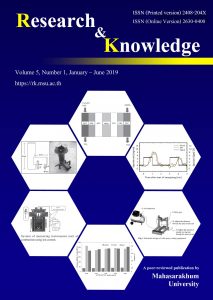Cold Spray Parameters for White Portland Cement Coating on Stainless Steel
Keywords:
White Portland cement, Stainless steel costing, Cold sprayAbstract
This research aims to study parameters that affect white Portland cement coating on 316L stainless steel using the cold spray technique in order to achieve 100-150 μm of coating thickness. The evaluation parameters, which were studied are: 1) speed of the sample moving pass through the spray nozzle 2) size of the spray nozzle 3) distance between the coating nozzle and sample surface 4) coating repetition. After the cold spray process, the thickness of the specimen was analyzed using an optical microscope. From preliminary experiments, the results showed that the nozzle of 1.2 mm with the speed of the sample moving pass through the nozzle of 600 cm/min produced good surface condition and satisfying distribution of coating area on coated sample. In addition, a distance between the nozzle of 20 cm with twice coating times, was the optimum condition created 132 μm of coating thickness of the coated sample.
References
Abdullah, D., et al. (2002). An evaluation of accelerated Portland cement as a restorative material, Biomaterials, vol. 23(19), October 2002, pp. 4001–4010.
Baptista. R., et al. (2016). Characterization of titaniumhydroxyapatite biocomposites processed by dip coating, Materials Science, vol. 39(1), February 2016, pp. 263–272.
Chaipanich, A., and Torkittikul, P. (2011). Microstructure: Surface and cross-sectional studies of hydroxyapatite formation on the surface of white Portland cement paste in vitro, Applied Surface Science, vol. 257(20), August 2011, pp. 8385-8390.
Coleman, N., et al. (2007). A preliminary investigation of the in vitro bioactivity of white Portland cement, Cement and Concrete Research, vol. 37, November 2007, pp. 1518–1523.
Dey, A., et al. (2009). Characterization of microplasma sprayed hydroxyapatite coating, Thermal Spray Technology, vol. 18(4), December 2009, pp. 578– 592.
Gallego, D., et al. (2008). Bioactive coatings on Portland cement substrates: Surface precipitation of apatitelike crystals, Materials Science and Engineering C, vol. 28(3), April 2008, pp. 347–352.
Gopi, J., et al. (2013). Hydroxyapatite Coating on Selectively Passivated and Sensitively Polymer-Protected Surgical Grade Stainless Steel, Applied Electrochemistry, vol. 43(8), March 2013, pp. 331–345.
Ishikawa, K., et al. (1997). Blast coating method: New method of coating titanium surface with hydroxyapatite at room temperature, Biomedical Materials Research, vol. 38(2), February 1997, pp. 129-134.
Lu, Y., et al. (2004). Plasma-sprayed hydroxyapatite + titania composite bond coat for hydroxyapatite coating on titanium substrates, Biomaterials, vol. 25(18), August 2004, pp. 4393-4403.
Pangdaeng, S., et al. (2015), Apatite formation on calcined kaolin–white Portland cement geopolymer, Materials Science and Engineering C, vol. 51, June 2015, pp. 1-6.
Torkittikul, P. and Chaipanich, A. (2009). Investigation of the mechanical and in vitro biological properties of ordinary and white Portland cements, Science Asia, vol. 35(4), December 2009, pp. 358–364.
Torkittikul, P. and Chaipanich, A. (2012). Optimization of calcium chloride content on bioactivity and mechanical properties of white Portland cement, Materials Science and Engineering C, vol.32(2), March 2012, pp. 282-289.
Downloads
Published
How to Cite
Issue
Section
License

This work is licensed under a Creative Commons Attribution-NoDerivatives 4.0 International License.







